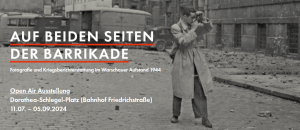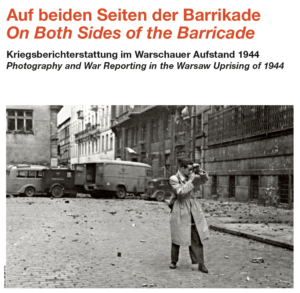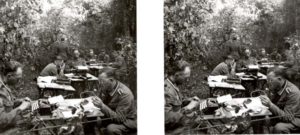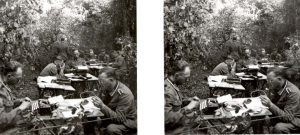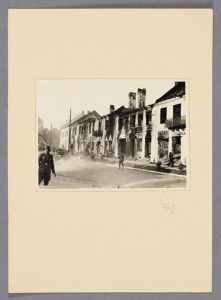Auf Ruinen sitzend, den Hut in der Hand
Quelle: https://visual-history.de/2024/06/17/katz-auf-ruinen-sitzend-den-hut-in-der-hand/
Stefan Arczynski (1916-2022)
Am 28. August 2022 ist der Breslauer Fotograf Stefan Arczyński kurz nach seinem 106. Geburtstag nach langer Krankheit verstorben. Das Herder-Institut ist seit Jahrzehnten mit ihm verbunden und bewahrt einen wesentlichen Teil seines umfangreichen fotografischen Œuvres. Wir trauern daher mit seiner Frau Lidia Arczyńska und der Familie um einen wunderbaren Menschen und um einen herausragenden Fotografen und Künstler.
Wer Stefan Arczyński bei Besuchen in Breslau oder auch bei seinem Aufenthalt in Marburg persönlich kennengelernt hat, war sehr beeindruckt von der Persönlichkeit, seinen wachen, geschärften Sinnen, seinem Humor, seinen umfangreichen Interessen und nicht zuletzt von dem Künstler, denn neben seiner dokumentarischen Fotografie verfolgte er auch künstlerische Ambitionen.
Der 1916 in Essen geborene Sohn von Emigranten aus Großpolen, der im Zweiten Weltkrieg auf deutscher Seite kämpfen musste und in sowjetische Gefangenschaft geriet, hat sich danach im nun polnischen Schlesien niedergelassen und schließlich in Breslau/ den größten Teil seines Lebens verbracht, wo ihm für sein Wirken und sein Lebenswerk schließlich die Ehrenbürgerwürde verliehen wurde.
[...]
Quelle: https://visual-history.de/2022/09/16/popp-stefan-arczynski-1916-2022/
Fotografie und Kriegsberichterstattung im Warschauer Aufstand 1944
Zum 70. Jahrestag des Warschauer Aufstands ließ die Landeszentrale für politische Bildung in Hamburg in Zusammenarbeit mit dem Arbeitsbereich Public History der Universität Hamburg, dem Museum des Warschauer Aufstands in Warschau sowie dem Verlag Leica Fotografie International eine historisch-fotografische Ausstellung unter dem Titel „Auf beiden Seiten der Barrikade. Fotografie und Kriegsberichterstattung im Warschauer Aufstand 1944“ erarbeiten. Die Ausstellung wurde am 1. Oktober 2014 im Mahnmal St. Nikolai in Hamburg eröffnet und ist seitdem an mehreren Orten in Deutschland präsentiert worden.
Ausgangspunkt für dieses Projekt war die Entdeckung, dass neben deutschen Fotografen, die den Aufstand dokumentiert haben – Mitglieder der Propagandakompanien (PK) der Wehrmacht und SS, die seit den 1930er Jahren standardmäßig mit Leica-Kameras ausgestattet wurden –, auch die Mehrzahl der Fotograf*innen unter den polnischen Kriegsberichterstatter*innen (PSW – Prasowi Sprawozdawcy Wojenni) mit einer Leica in Warschau fotografierte. Doch den Warschauer Aufstand nur auf der Ebene der technischen Ausrüstung zu betrachten, würde dem historischen Ereignis nicht gerecht werden. Das Kurator*innen-Team um Aleksandra Duralska (Museum des Warschauer Aufstands) und David Rojkowski (Leica Fotografie International) entschloss sich daher, seinen Fokus auf die Verwendung der Fotografien in der damaligen deutschen und polnischen Presse zu richten und sich kritisch den Pressefotografien als historischen Quellen zu nähern.
[...]
EU Rechtsstaatlichkeitsbericht 2020
Erstmals hat die Europäische Kommission 2020 einen Rechtsstaatlichkeitsbericht vorgelegt. Das gesamte Werk umfasst rund 100 Dateien!
Der Beitrag EU Rechtsstaatlichkeitsbericht 2020 erschien zuerst auf Wolfgang Schmale.
EU Rechtsstaatlichkeitsbericht 2020
Erstmals hat die Europäische Kommission 2020 einen Rechtsstaatlichkeitsbericht vorgelegt. Das gesamte Werk umfasst rund 100 Dateien!
Der Beitrag EU Rechtsstaatlichkeitsbericht 2020 erschien zuerst auf Wolfgang Schmale.
“Juden unter sich”
One of the most influential anti-Semitic propaganda actions produced in the Third Reich in the years 1939-1941 was based on images and reports from various ghettos in occupied Poland. Large portion of the raw material required for the anti-Semitic propaganda was collected and delivered by the Propagandakompanien (PK) of the Wehrmacht.[1] In order to analyze and understand the significance of this contribution, it is necessary to look not only at the propaganda materials, but also at the historical contexts in which they were produced. This includes organizational aspects, local conditions, general propaganda strategies and the given general and local war situation.
This article will examine the contribution of the Wehrmacht to the anti-Semitic propaganda of the “Third Reich” during three periods: The invasion of Poland, the establishment of a new order in the occupied Polish territories and the months preceding “Operation Barbarossa” in 1941. It will focus on the way PK materials were used mainly in the visual media in order to support the propaganda strategies and their subsequent goals set by the Nazi leadership.
General remarks regarding the propaganda organization of the “Third Reich”
[...]
“Juden unter sich”
One of the most influential anti-Semitic propaganda actions produced in the Third Reich in the years 1939-1941 was based on images and reports from various ghettos in occupied Poland. Large portion of the raw material required for the anti-Semitic propaganda was collected and delivered by the Propagandakompanien (PK) of the Wehrmacht.[1] In order to analyze and understand the significance of this contribution, it is necessary to look not only at the propaganda materials, but also at the historical contexts in which they were produced. This includes organizational aspects, local conditions, general propaganda strategies and the given general and local war situation.
This article will examine the contribution of the Wehrmacht to the anti-Semitic propaganda of the “Third Reich” during three periods: The invasion of Poland, the establishment of a new order in the occupied Polish territories and the months preceding “Operation Barbarossa” in 1941. It will focus on the way PK materials were used mainly in the visual media in order to support the propaganda strategies and their subsequent goals set by the Nazi leadership.
General remarks regarding the propaganda organization of the “Third Reich”
[...]
“Juden unter sich”
One of the most influential anti-Semitic propaganda actions produced in the Third Reich in the years 1939-1941 was based on images and reports from various ghettos in occupied Poland. Large portion of the raw material required for the anti-Semitic propaganda was collected and delivered by the Propagandakompanien (PK) of the Wehrmacht.[1] In order to analyze and understand the significance of this contribution, it is necessary to look not only at the propaganda materials, but also at the historical contexts in which they were produced. This includes organizational aspects, local conditions, general propaganda strategies and the given general and local war situation.
This article will examine the contribution of the Wehrmacht to the anti-Semitic propaganda of the “Third Reich” during three periods: The invasion of Poland, the establishment of a new order in the occupied Polish territories and the months preceding “Operation Barbarossa” in 1941. It will focus on the way PK materials were used mainly in the visual media in order to support the propaganda strategies and their subsequent goals set by the Nazi leadership.
General remarks regarding the propaganda organization of the “Third Reich”
[...]
Stumme Zeugnisse 1939
Foto: Svea Hammerle, Gedenk- und Bildungsstätte Haus der Wannsee-Konferenz © mit freundlicher Genehmigung
Am 1. September 1939 begann mit dem Überfall auf Polen der Zweite Weltkrieg. In Polen ist dies ein wichtiges historisches Datum und Anlass zum Gedenken und Erinnern. In der deutschen Erinnerungslandschaft hingegen ist der 1. September kein herausgehobener Tag. Welche Informationen haben wir über den Beginn des Zweiten Weltkrieges? Welche Bilder sind überliefert? Und welche privaten Erinnerungen – Fotoalben, Tagebucheinträge und Briefe aus dieser Zeit – haben Familien aufbewahrt?
[...]
Quelle: https://www.visual-history.de/2019/09/01/stumme-zeugnisse-1939/
